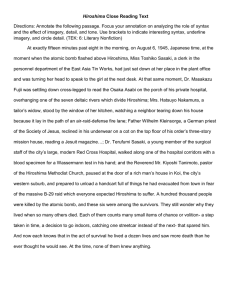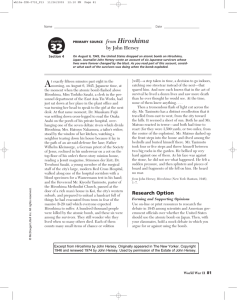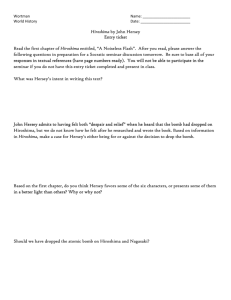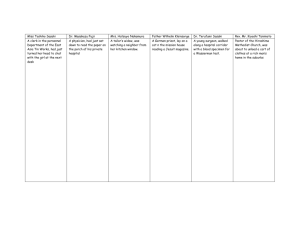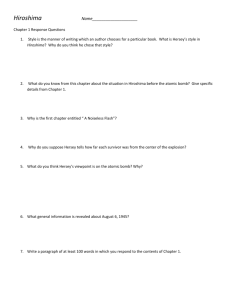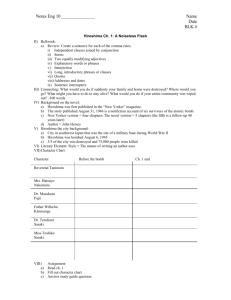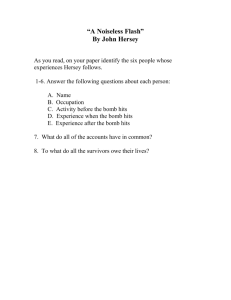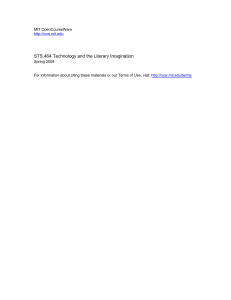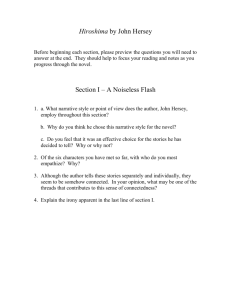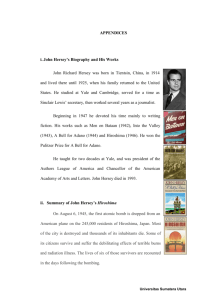Hiroshima
advertisement
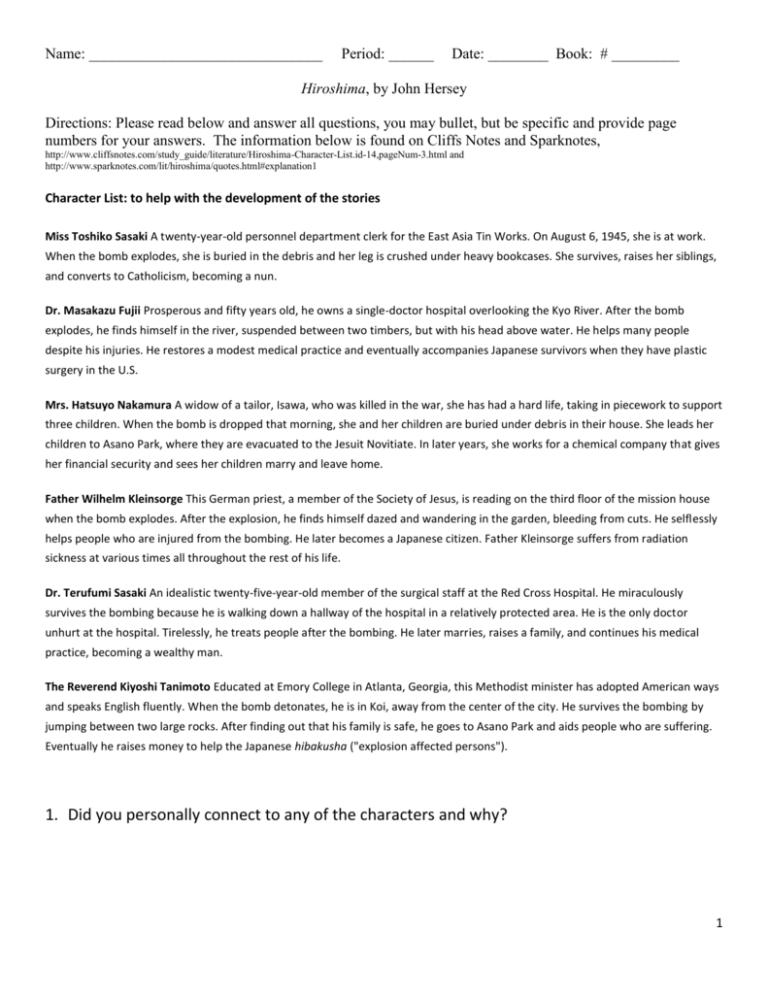
Name: _______________________________ Period: ______ Date: ________ Book: # _________ Hiroshima, by John Hersey Directions: Please read below and answer all questions, you may bullet, but be specific and provide page numbers for your answers. The information below is found on Cliffs Notes and Sparknotes, http://www.cliffsnotes.com/study_guide/literature/Hiroshima-Character-List.id-14,pageNum-3.html and http://www.sparknotes.com/lit/hiroshima/quotes.html#explanation1 Character List: to help with the development of the stories Miss Toshiko Sasaki A twenty-year-old personnel department clerk for the East Asia Tin Works. On August 6, 1945, she is at work. When the bomb explodes, she is buried in the debris and her leg is crushed under heavy bookcases. She survives, raises her siblings, and converts to Catholicism, becoming a nun. Dr. Masakazu Fujii Prosperous and fifty years old, he owns a single-doctor hospital overlooking the Kyo River. After the bomb explodes, he finds himself in the river, suspended between two timbers, but with his head above water. He helps many people despite his injuries. He restores a modest medical practice and eventually accompanies Japanese survivors when they have plastic surgery in the U.S. Mrs. Hatsuyo Nakamura A widow of a tailor, Isawa, who was killed in the war, she has had a hard life, taking in piecework to support three children. When the bomb is dropped that morning, she and her children are buried under debris in their house. She leads her children to Asano Park, where they are evacuated to the Jesuit Novitiate. In later years, she works for a chemical company that gives her financial security and sees her children marry and leave home. Father Wilhelm Kleinsorge This German priest, a member of the Society of Jesus, is reading on the third floor of the mission house when the bomb explodes. After the explosion, he finds himself dazed and wandering in the garden, bleeding from cuts. He selflessly helps people who are injured from the bombing. He later becomes a Japanese citizen. Father Kleinsorge suffers from radiation sickness at various times all throughout the rest of his life. Dr. Terufumi Sasaki An idealistic twenty-five-year-old member of the surgical staff at the Red Cross Hospital. He miraculously survives the bombing because he is walking down a hallway of the hospital in a relatively protected area. He is the only doctor unhurt at the hospital. Tirelessly, he treats people after the bombing. He later marries, raises a family, and continues his medical practice, becoming a wealthy man. The Reverend Kiyoshi Tanimoto Educated at Emory College in Atlanta, Georgia, this Methodist minister has adopted American ways and speaks English fluently. When the bomb detonates, he is in Koi, away from the center of the city. He survives the bombing by jumping between two large rocks. After finding out that his family is safe, he goes to Asano Park and aids people who are suffering. Eventually he raises money to help the Japanese hibakusha ("explosion affected persons"). 1. Did you personally connect to any of the characters and why? 1 Important Quotations Explained: The examples below are here to help to help you understand the symbolism, what Hersey was developing so you can develop your critical thinking skills, to go beyond the content “There, in the tin factory, in the first moment of the atomic age, a human being was crushed by books.” : This powerful quotation, referring to Miss Sasaki’s injury after the atomic explosion, ends the first chapter of Hiroshima. The image is powerful because it juxtaposes very disparate elements. Both tin factories and books represent technologies that have become old-fashioned in the atomic age. Books are mundane and nonthreatening, whereas the force of the blast is almost beyond human comprehension. On the other hand, both books and “the atomic age” suggest human knowledge turning on human beings to destroy them. Miss Sasaki is crushed because of the misuse of scientific knowledge, and the fact that books literally fall on her and crush her symbolically underscores this idea. “Why have you not come to Asano Park? You are badly needed there.” Without even looking up from his work, the doctor said in a tired voice, “This is my station.” “But there are many people dying on the riverbank over there.” “The first duty,” the doctor said, “is to take care of the slightly wounded.” “Why—when there are many who are heavily wounded on the riverbank?” The doctor moved to another patient. “In an emergency like this,” he said, as if he were reciting from a manual, “the first task is to help as many as possible—to save as many lives as possible. There is no hope for the heavily wounded. They will die. We can’t bother with them.” “That may be right from a medical standpoint—” Mr. Tanimoto began, but then he looked out across the field, where the many dead lay close and intimate with those who were still living, and he turned away without finishing his sentence, angry now with himself. : In this exchange in Chapter Three, Hersey depicts the overwhelming sense of hopelessness that many of the uninjured felt when faced with so many others’ pain and death. Mr. Tanimoto tries to blame the doctors for not doing more to help. However, in this scene he realizes that there are not enough doctors to care for the thousands of injured people, and that most of the seriously injured will simply be left to die. Hersey mentions in Chapter Two the fact that out of 150 doctors in Hiroshima, sixty-five were killed and most of the rest were wounded. Out of 1,780 nurses, 1,654 were either dead or too badly hurt to help anyone. Compounding the tragedy of Hiroshima was this lack of medical care. Doctors and nurses were either killed or injured, or they had no access to hospitals, medical supplies, and resources. Many injured people could have survived the explosion with proper treatment, but there was simply no one to provide it. In this passage, Hersey forces us to face this fact, and thus, other ramifications of the atom bomb explosion. 2. What is the historical context for this book? 3. Do you feel America was justified in dropping two atomic bombs so WWII would come to a close? Do you feel there was an alternative way to end WWII? 4. What were your overall feelings after reading this book (please answer last): 2

